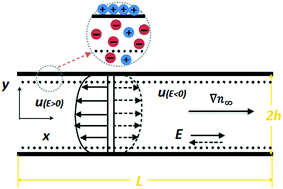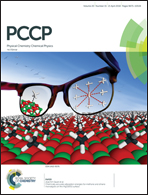Theory of diffusioosmosis in a charged nanochannel†
Abstract
We probe the diffusioosmotic transport in a charged nanofluidic channel in the presence of an applied tangential salt concentration gradient. Ionic salt gradient driven diffusioosmosis or ionic diffusioosmosis (IDO) is characterized by the generation of an induced tangential electric field and a diffusioosmotic velocity (DOSV) that is a combination of an electroosmotic velocity (EOSV) triggered by this electric field and a chemiosmotic velocity (COSV) triggered by an induced tangential pressure gradient. We explain that unlike the existing theories on IDO, it is more appropriate to apply the zero net current conditions (formulation F2) and not more restrictive zero net local flux conditions (formulation F1) particularly for the case where one considers a nanochannel connected to two reservoirs. We pinpoint limitations in the existing literature in correctly predicting the diffusioosmotic behavior even for the case where formulation F1 is used. We address these limitations and establish that (a) the induced electric field is an interplay of the differences in ionic diffusivity, the EDL-induced imbalance in ion concentrations, and the advection effects, (b) formulation F1 may overpredict or underpredict the electric field and the EOSV leading to an overprediction/underprediction of the DOSV and (c) formulation F2 demonstrates remarkable fluid physics of localized backflows owing to a dominant local influence of the COSV, which is missed by formulation F1. We anticipate that our theory will provide the first rigorous understanding of nanofluidic IDO with applications in multiple areas of low Reynolds number transport such as biofluidics, microfluidic separation, and colloidal transport.



 Please wait while we load your content...
Please wait while we load your content...